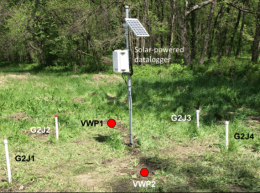The Kansas Water Resources Institute (KWRI) develops and supports research on high-priority water resource problems as defined by the Kansas state water plan. KWRI is designed to facilitate effective communication between water resources professionals and to foster the dissemination and application of research results. Continue reading “KWRI focuses on Kansas water issues”
Category: December 2018
Monitoring the Effectiveness of Streambank Stabilization Projects in Northeast Kansas
Streambank stabilization projects represent a key element in the plan to reduce sediment in Kansas waterways and reservoirs. In this project, investigators worked to quantify the environmental benefits of government-sponsored streambank stabilization and restoration projects in northeastern Kansas, with a special focus on sites within the Kickapoo Tribe in Kansas and Prairie Band Potawatomi Nation Indian Reservations. Continue reading “Monitoring the Effectiveness of Streambank Stabilization Projects in Northeast Kansas”
Contaminant barriers or pathways? Hydraulic and chemical methods to improve characterization of shallow aquitards

Shallow aquifers are heavily used for drinking water and irrigation. These aquifers are often part of multi-layered systems where confining layers, also known as aquitards, can “isolate” an aquifer from poorer quality waters that can lie either above or below them. The aquitard’s capability to isolate is estimated using the vertical component of hydraulic conductivity (K). Accurate estimates of vertical K are needed when it comes to protecting groundwater used for human supply.

This project investigated different methods, both hydraulic and chemical, to estimate the vertical K of an aquitard in the field. The key questions commonly faced by practicing hydrogeologists are what method is the most appropriate for a particular application, and how much uncertainty is associated with the method selected. To answer these questions, the research team tested two common approaches for aquitard K characterization at a Kansas Geological Survey field site. The first was a chemical method based on porewater concentrations at different depth intervals; the second was a hydraulic method based on the monitored pressure at different depth intervals in response to well constructions and water level fluctuations in the underlying aquifers. Continue reading “Contaminant barriers or pathways? Hydraulic and chemical methods to improve characterization of shallow aquitards”
Quantifying Ephemeral Gully Erosion and Evaluating Mitigation Strategies with Field Monitoring and Computer Modeling
Soil erosion causes severe soil degradation and significantly contributes to soil loss in agricultural fields, with some producers losing substantial amounts of arable land each season.

To combat this soil loss, it is important to understand the mechanisms related to ephemeral gully formation and location, as well as the geomorphological properties related to storm characteristics. This three-year project works focused on these goals, as well the quantification of soil loss in Kansas resulting from ephemeral gully erosion. Continue reading “Quantifying Ephemeral Gully Erosion and Evaluating Mitigation Strategies with Field Monitoring and Computer Modeling”
Assessing the impact of constructed wetlands on nitrogen transformation and release from tile outlet terraces (TOTs) in Kansas
This project focused on the influence of tile outlet terrace (TOT) croplands on nitrogen and sediment fluxes. Specifically, researchers concentrated on three TOT fields, where the tiles drained to constructed wetlands.
In this course of the research, investigators measured water fluxes and water chemistry into and out of the wetlands during wet weather periods. Rainfall, water velocity and water levels were measured continuously. Automated samplers assessed water chemistry during storm events, and grab samples were collected weekly/biweekly from within the wetlands in order to understand wetland water chemistry variability. During the final year of the project, researchers continued collecting water samples and soil water in fields using lysimeters. They also completed a bulk chemical analysis of soil. These data were used together to separate storm hydrographs to event and pre-event water, to determine the sources and interactions of pre-event water and to develop a conceptual model of nitrogen transformation and flux for TOT systems.
Project Leaders:
Pamela L. Sullivan, Department of Geography and Atmospheric Science, University of Kansas
Edward Peltier, Civil and Environmental and Architectural Engineering, University of Kansas
Governor’s Conference on the Future of Water in Kansas
The fifth statewide “Governor’s Conference on the Future of Water in Kansas” was held on November 8-9, 2017 in Manhattan, Kansas. The conference was highly successful with 691 people registered and attending. Attending the conference was the Governor of Kansas, Sam Brownback, and several state and national senators and representatives. The governor fully supports this conference and has expressed his concern about the issue of preserving and protecting the future viability of water in Kansas. The conference also included 35 volunteer scientific and four invited presentations, which were presented in plenary and concurrent sessions. Conference participants also had opportunities to attend four panel discussions. In the scientific poster session, there were eight faculty/staff/professional scientific posters and 33 student posters presented. A student poster award program (for both graduate and undergraduate posters) was conducted to encourage student participation.